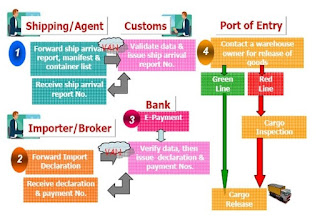Import Procedures
Import
Import is explained as bringing products into own country from a
place outside the national border. It can be said that Import trade refers to the
purchase of goods from a foreign country. The procedure for import trade varies
from country to country depending upon the import policy, statutory
requirements, and customs policies of different countries. In almost all
countries of the world import trade is controlled by the government. The aims
of these controls are the appropriate use of foreign exchange restrictions, protection
of indigenous industries, etc. The imports of goods have to follow a procedure.
A manufacturer's import department often grows out of the
purchasing department, whose personnel have been assigned the responsibility of
procuring raw materials or components for the manufacturing process. For
importers or trading companies that deal in finished goods, the import
department may begin as a result of being appointed as the distributor for a
foreign manufacturer (Johnson, 2010).
In the Indian context, the import and export of goods is ruled by
the Foreign Trade (Development & Regulation) Act, 1992, and India’s Export-Import (EXIM) Policy. India’s Directorate General of Foreign Trade (DGFT) is
the major governing body and is responsible for all issues associated with EXIM
Policy. Importers are essential to register with the DGFT to obtain an Importer
Exporter Code Number (IEC) issued against their Permanent Account Number (PAN),
before engaging in EXIM activities. After an IEC has been obtained, the source
of items for import must be identified and declared. The Indian Trade
Classification – Harmonized System (ITC-HS) allows for the free import of most
goods without a special import license.
Basic Import Procedures
- Setting Market
Objectives:
- Setting market
objectives on pricing and terms
- Sourcing Products:
- Identifying
potential suppliers
- Sourcing channels
of distribution
- Trade Regulations:
- Import
regulations and requirements, and checking whether an import license is
required
- Patent, trademark, and copyright
- Making Contacts:
- Sending enquiries
to suitable suppliers
- Settling Quotation
and Terms:
- Analyzing the
supplier's quotation and offers
- Costs and terms
of sale
- Financing the
Purchase:
- Preparing for
working capital
- Types of bank
financing and applications, such as exporter credit or other bank
facilities
- Sales Contract:
- Confirming the
sales contract and terms of transaction such as payment terms.
- Preparing Payment
and Insurance:
- Preparing
payments and insurance specified in the sales contract (eg. when the payment term
is D/C, submit a D/C application to the issuing bank; when the trade term is
FOB, arrange a cover note with an insurance company).
- Preparing
insurance, and cover notes, when necessary
- Acquiring Goods:
- Receiving
shipping advice and arrival notice
- Receiving export
documents from the exporter
- Collecting goods
from the specified shipping company or forwarder
- Customs Clearance:
Arranging customs clearance and import declaration
Import Procedure

All importers must have to follow detailed customs clearance formalities
when importing goods into India. A complete overview of EXIM procedures can be
found on the Indian Directorate of General Valuation's website.
It is established in finance literature that smooth, efficient, and compliance-oriented exporting, and importing needs specialized knowledge of
personnel. In many companies, some or all functions of the export and import
department are combined in some way. In smaller companies, where the volume of
export and import does not justify more personnel one or two persons may have
responsibility for both export and import documentation and procedures. In
giant companies, these functions tend to be separated into the export department
and import department (Johnson, 2010).
It is beneficial for companies to have export and import manual
of procedures and documentation. These manuals serve as an effective tool for
smooth operations and as a training tool for new employees. Exporters and
importers must maintain records relating to their international trade
transactions. Many companies offer software programs for managing the export
process such as order taking, generating of export documentation compliance
with export control regulations, and calculation of transportation charges and
duties. On the import side, many companies offer supply chain management software.








No comments